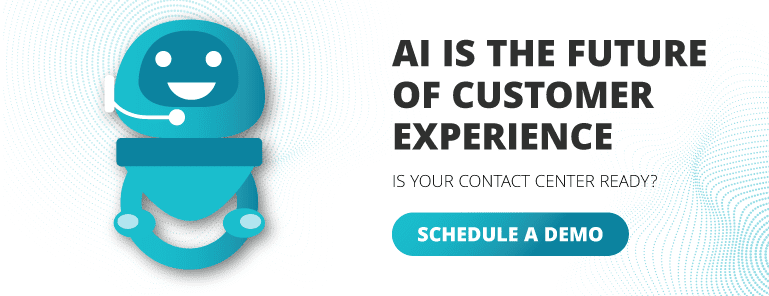Home maintenance is tricky. Even the simplest tasks require me to watch five YouTube videos (and then panic a bit) before I feel confident enough to try them out myself.
Plus, you need all the right tools on hand before you can start a project. Without the right tools, a simple project like swapping out a light fixture becomes a major headache. I can’t tell you how many times I’ve turned my home into a total disaster only to realize I need to make a trip to the hardware store…and then go back three more times. My home is a mess, and my grumpiness ruins not only my day but also my husband’s. All because I lacked the right tools to succeed.
It’s no different in a contact center. Without the right tools, disaster ensues. Service is slow. Processes are clunky. Agents are stressed. And customers get grumpy. Yet, with the right set of tools, those tasks are easy-peasy.
So, what tools do you need? Let’s dig into nine must-have contact center automation tools that make agents’ lives easier. (And boost your CSAT!)
9 Contact Center Automation Tools that Make Life as an Agent Easier
1. Chatbots and Virtual Assistants (VAs)
Evidence shows that chatbots offer agents critical support. In fact, businesses have saved over 2.5 billion customer service hours thanks to chatbots. And customers want to use them! Nearly 74% of consumers prefer using chatbots for simple questions.
Ultimately, chatbots and VAs make life easier for agents. They handle simple tasks and customer interactions across every channel. (For real — check out Broadvoice’s IVAs to see for yourself). So, by offloading these repetitive tasks to VAs, agents have more time to focus on the most relevant, high-priority customer interactions.
This leads to greater job satisfaction and reduced stress. Plus, customers get instant responses and better attention when an issue gets complex.
Check out our IVAs to see for yourself how they work.
2. Interactive Voice Response (IVR) Systems
Like chatbots and VAs, IVR systems reduce agent workloads. These tools improve call routing by gathering critical information from customers. After guiding customers through a series of options, IVR systems let customers resolve issues on their own. If the problem can’t be resolved autonomously, the IVR directs the customer to an appropriate agent based on their needs.
IVR systems ensure agents only receive calls that align with their skills. This increases both efficiency and effectiveness. With an automated IVR system (like Broadvoice’s), agents get time to focus on the tasks they’re best equipped to handle. Hello, streamlined operations!
By guiding customers to the right resources and agents, IVRs reduce wait times and enhance CSAT scores.
3. Robotic Process Automation (RPA)
Individuals spend over 300 hours a year on administrative tasks. And the average admin task wastes up to 20% of productivity. Think of what agents could do with an extra 300 hours each year!
RPA bots help reduce these pesky tasks. They handle routine back-office tasks, such as data entry, updating accounts, handling emails, and processing transactions.
By automating administrative tasks, RPA frees agents from mundane and repetitive work. Agents feel more productive and can dedicate more time to high-level support activities. And their work becomes more dynamic and engaging. For customers, RPA improves service delivery speed and accuracy. This leads to improved FCR, fewer errors, and higher satisfaction levels.
Stay on trend with contact center automation. Here are 10 trends you can’t afford to miss!
4. Sentiment Analysis and Natural Language Processing (NLP)
What if you could read customers’ minds? With sentiment analysis and NLP tools, you kind of can.
Sentiment analysis tools assess customer emotions and language during interactions. Then, they offer insights and suggestions to improve the interaction. This lets agents adjust their responses based on the customer’s emotional state. Plus, NLP tools provide a better understanding of customer queries. This added context helps agents enhance the accuracy of responses and the customer experience.
5. Intelligent Call Routing
As many as 90% of consumers expect an immediate response to their customer service questions. Intelligent routing systems make this possible. With intelligent call routing, you can direct customers to the best-suited agent based on their needs, past behavior, and the agent’s skills.
Intelligent routing matches customers with the agents best equipped to help. This leads to more successful interactions and reduces the likelihood of tense or frustrating conversations. Agents are set up to succeed and use their strengths, supporting greater job satisfaction.
Intelligent routing also gives customers the immediate help they’re looking for. This means you can cut wait times and drive faster, more effective resolutions.
6. Agent Assist Tools
Agents always need a helping hand. But as the manager, you can’t help everyone all the time. Agent assist tools provide real-time context, generative AI scripts, and suggested actions during live calls.
Agent assist tools reduce agents’ cognitive load by delivering relevant information when it’s needed most. This boosts agent confidence and efficiency, allowing them to handle calls faster and with fewer errors. Faster problem resolution and more accurate responses also enhance the entire customer experience.
Change the game with AI agent assist. Check out our blog to learn more.
7. Predictive Analytics
There’s no question about it: contact centers are packed with valuable data. But how do you use it strategically? AI and automation can help. Predictive analytics optimize data usage so you can anticipate customer needs with greater accuracy. You can use them to forecast demand. Then, gain recommendations for the next-best action during interactions.
With AI-powered analytics, you can empower agents with valuable insights so they can proactively address customer concerns. This predictive approach helps agents resolve issues faster, improving their efficiency and success rate. Plus, your CSAT will improve when you deliver more personalized service and quicker resolutions.
8. Workforce Management (WFM) and AI Scheduling
Overworking or underworking agents is a recipe for burnout (and, eventually, turnover). WFM tools and AI-driven scheduling reduce over- and understaffing issues. With these tools, you can optimize agent schedules, monitor performance, and forecast staffing needs using AI insights.
WFM tools reduce the stress on agents by ensuring balanced workloads. And by optimizing schedules and predicting peak times, they also help agents perform at their best, improving morale and job satisfaction.
AI scheduling also ensures agents are available when demand is highest. As a result, customers experience shorter wait times and more consistent service.
9. AI-Powered Quality Assurance (QA) Tools
Quality matters as much as quantity in customer service. With AI-powered QA, you can automatically analyze customer interactions to assess performance, compliance, and effectiveness. These tools identify patterns, detect issues, and provide actionable feedback on agent performance.
This eliminates manual monitoring, so agents get immediate insights into their performance. This real-time feedback helps agents refine their approach. As their skills improve, your service meets quality standards without agents feeling micromanaged.
By ensuring high-quality interactions, AI-powered QA tools help agents deliver consistent, accurate, and empathetic service. As agent performance improves, you’ll also see higher levels of customer satisfaction.












